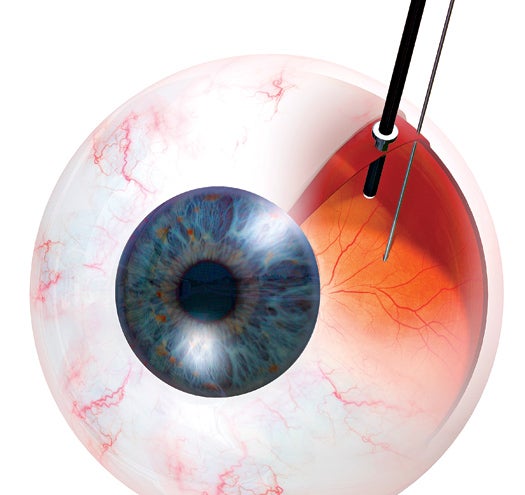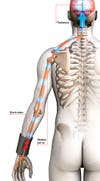Frontiers of Medicine: Radical Cures
Doctors seek inspiration from unexpected sources to work toward solving some of medicine's toughest challenges

Blindness, brain cancer, vegetative states: These are among the most hopeless conditions without cures—yet. Now doctors are turning to unorthodox methods to solve some of medicine’s most intractable challenges. The early results are in, and they look promising.
RESTORING SIGHT
Challenge: A genetic disease degrades sight in children and blinds them by adulthood.
Radical Cure: Replace the defective genes with healthy ones.
Status: Three to five years to FDA approval
Tami Morehouse was afraid to open her eyes at the sound of her alarm clock every morning. Her vision had deteriorated to a brown haze over the past three years. She couldn’t tell the sky from the ocean or make out people’s faces. The 45-year-old mother of three knew that, eventually, she would wake up one day and her world would be black. But a couple of weeks after doctors injected one eye with new genes, she could see the refrigerator door. Four months later, she watched her 12-year-old daughter steal third base.
Morehouse has Leber’s congenital amaurosis, a single-gene defect that prevents the retina from producing the proteins that play a vital role in maintaining the health of the eyes’ light receptors. For most sufferers, vision begins failing in early childhood. Without the treatment, there is no question that she, or any other sufferer of LCA, will eventually go totally blind. But Morehouse was among 11 other LCA patients, ranging in age from eight to 33 years old—”I was the oldest, blindest pioneer,” she jokes—in a recent clinical trial at the Children’s Hospital of Philadelphia. They received a shot of genes near their retinal cells to repair their light receptors. Although most of the participants entered the trial with vision similar to the brown haze that Morehouse experienced, today at least six of the participants’ vision has improved such that they are no longer considered legally blind.
The therapy stems from nearly 20 years of research on hereditary blindness in mice and dogs by Jean Bennett, a molecular geneticist at the University of Pennsylvania School of Medicine. With additional studies, Bennett says that she could have a drug ready in three years that any retinal surgeon could administer to cure LCA. But she’s not stopping there. Only five children born in the U.S. annually have the same type of LCA as Morehouse, but focusing on a rare single-gene defect is a good way to develop a model for treating more common ailments. “Our success shows that this technique is possible,” Bennett says. “We think this could be a platform for a lot of different blinding diseases.” Within the decade, she says, therapies involving similar eye genes could improve sight in people with other mutations, such as retinitis pigmentosa or macular degeneration.
Morehouse, like the other patients in the first study, received an injection in only one eye (they left the other eye alone as a control). “Call me greedy,” she says, “but I keep reminding my doctors, ‘Please don’t forget my other eye.’ ” This spring, Bennett and her colleagues hope to continue to test the LCA gene therapy in both eyes of younger patients. Bennett is currently applying for additional funding for a larger trial and to finish treating her first 12 patients. She hopes it comes soon—the new genes can’t help once all the retinal cells have died: “It’s an emotional race for all of us.”

How It Works
A virus carrying copies of the healthy gene is injected near the eye’s retinal-pigment epithelium cells. The virus invades the cells, which convert the new genes into the proteins that supply the rods and cones with the vitamin A necessary to form the pigment that absorbs light and allows a person to see.
REVERSING AUTISM
Challenge: A mutation on the X chromosome is the most common known cause of autism.
Radical Cure: Inhibit a receptor to slow brain activity to normal levels.
Status: Possibly entering Phase II (human) trials this fall
Mark Bear’s mice weren’t well. They were aggressive, slow learners, and kept convulsing in seizures—classic signs of Fragile X syndrome. But when the Massachusetts Institute of Technology neuroscientist tweaked a single receptor in the mice’s brains, they began acting as if they had never been sick. Now he plans to do the same for people.
Fragile X syndrome, a single genetic mutation on the X chromosome, is the most common source of inherited mental impairment, affecting one in every 4,000 boys and one in every 6,000 girls. It’s also the most common cause of autism. Although patients may be able to pinpoint their parent’s car in a parking lot, they can’t perform most everyday tasks. Currently the only drugs available for the syndrome treat the overt symptoms, such as anxiety and aggression. Bear’s drug works at the syndrome’s physical source.
While studying mice, he learned that the disease allows a neuron’s mGluR5 receptor to send out a flurry of signals telling the cell to produce protein. The protein overload causes a neuron to form many more connections to other neurons than normal, creating chaos by spreading nerve instructions to too many cells. Bear’s drug, called STX107, inhibits the receptors to pare back the overproduction of proteins associated with Fragile X to a normal range. His company, Seaside Therapeutics, plans to test STX107 in patients this fall. If it works as well as it did in mice, Bear says, it could be a first step to treating other causes of autism.

Reversing Autism
How It Works
Fragile X neurons lack the ability to mute messages from the mGluR5 receptor, leading to an overproduction of protein. STX107 binds to the receptor, dampens its productivity, and slows protein production to a normal rate.
WAKING UP THE BRAIN-DEAD
Challenge: Only 3 to 7 percent of patients in vegetative or minimally conscious states recover.
Radical Cure: Jolt the brain back to life.
Status: Active in one specialty clinic
Steven Domalewski had just released the ball when the batter smacked it right back at him, hitting his chest so hard that his heart stopped. A doctor put the then 12-year-old pitcher on life support and said that he would never wake up from the vegetative state. Then neuroscientist Philip De Fina heard of the case and treated Domalewski with his one-of-a-kind therapy. The boy woke up six weeks later. Domalewski’s first doctor called the recovery a fluke. “We’re proud of our record of flukes,” De Fina says. He and his colleagues have a lot of them: They wake up 84 percent of their patients from a minimally conscious or vegetative state. The nationwide rate is less than 7 percent.

Waking Up the Brain
When a patient like Domalewski comes under the care of De Fina and Jonathan Fellus at the Kessler Institute in New Jersey, he doesn’t get the standard “life-sustaining” drug treatments. Instead, patients get a cocktail of therapies to jump-start their brain. First the doctors prescribe stimulants that boost mood-enhancing dopamine, as well as brain-arousing drugs normally used to treat depression, anxiety and Parkinson’s disease. Then it’s Narcan, a drug used to treat heroin overdoses that prevents natural endorphins from slowing a return to consciousness.
After two weeks, the doctors attach electrodes to each wrist that send pulses to the brain. The shocks draw blood to the brain, increasing levels of oxygen and glucose—brain food critical for everyday function—by 20 percent. In week five, patients receive vitamins, amino acids, herbs and minerals that decrease cell stress and promote normal synaptic transmission. This protocol has woken 43 patients from vegetative or minimally conscious states, with no major negative side effects.
With 320,000 vets returning from war with brain injuries, the U.S. Department of Defense has taken a new interest in caring for these patients and has awarded De Fina’s organization, the International Brain Research Foundation, $6.4 million to find what makes the treatment so effective. But patients are still the priority, Fellus says. “We want to get results first; then we’ll worry about how
it works.”
How It Works
Electrodes send electrical signals along the median nerve in each wrist, up the spinal cord and to the thalamus, the main relay station in the brain. The electrical activity excites the brain and increases oxygen- and glucose-rich blood flow to the cerebral cortex, the area of the brain that controls cognitive function, personality and emotion. Scientists think this helps stimulate new axon growth and rebuilds connections between damaged areas of the cerebral cortex.
STOPPING BRAIN TUMORS
Challenge: The most common malignant brain cancer kills more than 12,000 Americans a year.
Radical Cure: Inject a patient with proteins from his tumor; train immune system to hunt cancer.
Status: Entering Phase II trials
A diagnosis of glioblastoma is a death sentence. A surgeon can remove as much of the brain tumor as is safe and prescribe chemo- and radiation therapy, but the cancer will grow back. The luckiest few live half a decade; most survive just months. Now Andrew Parsa, a neurosurgeon at the University of California at San Francisco, has developed a treatment that could add years to patients’ lives.
Parsa’s plan of attack is familiar: He revs up a patient’s immune system to combat the extremely aggressive, persistent cancer the same way a vaccine helps the body fight the flu. After Parsa removes the tumor, he has a vaccine concocted from proteins specific to that tumor plus a ferrying compound, called a heat-shock protein, and injects it back into the patient over the course of four weeks. This prepares the immune system to produce fighter white blood cells, called T cells, that find and kill any new cancerous cells with proteins matching those extracted from the tumor.
In Parsa’s first study, in 2008, 12 vaccinated patients went on to live an average of 10 months longer after diagnosis of a recurrent tumor. Parsa began a new study last November of 10 newly diagnosed glioblastoma patients and, so far, reports seeing the same quick immune response in these patients that signals that the vaccine is working. Treating the disease as early as possible could extend their lives even longer, he says. “We have the potential to turn this horrible cancer into a simple, manageable chronic disease.”

How to Stop Brain Tumors
How It Works
1. Remove as much of the glioblastoma tumor tissue [pink] as is safe.
2. Isolate proteins [blue, purple] specific to the brain tumor and make into a vaccine.
3. Inject the patient with the vaccine. Antigen-presenting immune cells [light blue] introduce the tumor proteins to T cells [orange].
4. T cells seek out and destroy new cancerous cells with the matching protein signature, while leaving healthy cells [green] alone.